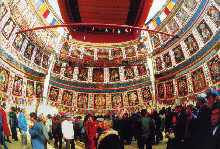 Because of boasting two monasteries, the village is divided into Upper and Lower Wutun. Living within the two monasteries are about 50 famous thangka artists. The two villages are full of monks and laypeople turning out masses of Buddhist art for monasteries as far away as western Tibet. The monastery in Upper Wutun, or Sengeshong Yago in Tibetan, is magnificently decorated, and the surface of the entire assembly hall has been carved and painted with traditional Regong designs.
Because of boasting two monasteries, the village is divided into Upper and Lower Wutun. Living within the two monasteries are about 50 famous thangka artists. The two villages are full of monks and laypeople turning out masses of Buddhist art for monasteries as far away as western Tibet. The monastery in Upper Wutun, or Sengeshong Yago in Tibetan, is magnificently decorated, and the surface of the entire assembly hall has been carved and painted with traditional Regong designs.
The most celebrated painter from Upper Wutun is Shawu Tsering (Chinese: Xiawucailang), one of Tibet's last "living masters" and "saviours" of the art of thangka painting. At the ripe old age of 80 this amazing man is still painting, though sometimes aided by his son. He was formally trained in his youth, and obtained his inspiration from many sources including the famous frescoes of theDunhuangcaves, the Ajanta frescoes of India, Central Asian painting and many others. He won international fame early in his painting career and has left many classic works for thousands of monasteries. He had passed on his knowledge of the proper iconography, an element so important to thangka painting, to many young talented artists of this area.
Lower Wutun, or Sengeshong Mago, is just about 10 minutes' walk from the upper village. It boasts a much livelier monastery as the location for ceremonies and festivities that draw crowds of local worshippers. Also important in terms of Regong art, this monastery has exquisite carvings and murals that are unequalled elsewhere.
 Longwu Monastery
Longwu Monastery
Arriving at the town of Longwu, which means agriculture section in Tibetan, visitors would never miss the Longwu Monastery which is a good example of the influence by Regong art.
Located in the south of town, it is one of the six biggest monasteries of Tibetan Buddhism in Qinghai Province with 500 monks. The local Tibetans are very proud of the Longwu Monastery as it is only next to the Labrang Monastery in Gansu Province and the Ta'er Monastery in Qinghai Province in terms of scale, status, and influence.
It was initially built by the Sakya Sect in 1301 of theYuan Dynasty(1271-1368). In the Ming (1368-1644) and Qing (1644-1911) dynasties, the Xiaricang Living Buddha system was formed here and the monastery changed into Gelukpa Sect. From then on, it dominated the region in religions and politics for about 200 years. The architecture of the Scripture Hall and other halls in the monastery is majestic with gorgeous decorations, boasting rich historical relics.
